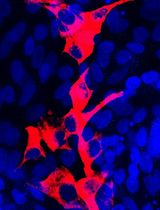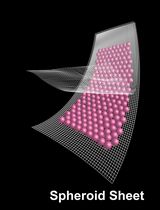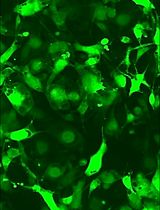- EN - English
- CN - 中文
One-step Derivation of Functional Mesenchymal Stem Cells from Human Pluripotent Stem Cells
人多能干细胞到功能性间充质干细胞的单步派生
发布: 2018年11月20日第8卷第22期 DOI: 10.21769/BioProtoc.3080 浏览次数: 9785
评审: Antoine de MorreeShweta GargAnthony Flamier
Abstract
Mesenchymal stem cells (MSCs) are invaluable cell sources for understanding stem cell biology and potential application in tissue engineering and regenerative medicine. The current issues of MSCs that demand to be further addressed are limited donors, tissue sources and limited capacity of ex vivo expansion. Here, we describe a simple and easy protocol for generating functional mesenchymal stem cells from human pluripotent stem cells (hPSCs) via one-step low glucose medium switch strategy in feeder-free culture system. In this protocol, human induced pluripotent stem cells (hiPSCs) and H9 human embryonic stem cells (hESCs) were successfully differentiated into MSCs, named hiPSC-MSCs and hESC-MSCs, respectively. The derived hiPSC-MSCs and hESC-MSCs exhibited common MSC characteristics as MSCs derived from human bone marrow (hBM-MSCs), including expressing MSC surface markers and possessing capability of tri-lineage differentiation in vitro (adipogenesis, osteogenesis and chondrogenesis). As compared with other available protocols, our protocol can be applied to generate a large number of MSCs from hPSCs with high efficiency, low-cost manner, moreover, not involving embryoid body, mouse feeder-cell, flow sorting, and pathway inhibitors (such as SB203580 and SB431542). We believe that this protocol could provide a robust platform to reach the future demand for producing the industrial scale of MSC from hPSCs for autologous cell-based therapy.
Keywords: Mesenchymal stem cells (MSCs) (间充质干细胞)Background
Mesenchymal stem cells (MSCs) are adult stem cell populations derived from postnatal tissues. They retain fast proliferation rate, self-renewal capabilities, and lineage-specific differentiation potential. Moreover, MSCs are capable of producing growth factors, having anti-apoptosis properties, lacking carcinogenicity (Trounson and McDonald, 2015), and no adverse effects noted thus far in clinical trials (Lalu et al., 2012). Therefore, MSCs represent promising cell candidates for stem cell-based therapy and regenerative medicine (Tuan et al., 2003; Chen et al., 2008). Functional MSCs have been well established from various tissues, including bone marrow (BM) (Noth et al., 2002), adipose tissue (Zuk et al., 2001), peripheral blood (da Silva Meirelles et al., 2006), umbilical cord blood (Lee et al., 2004; Schuh et al., 2009), and other human organs (Campagnoli et al., 2001; Crisan et al., 2008). Among them, BM is regarded as the most accessible and reliable source for MSCs in adults, considering the wide distribution and well-characterized isolation methodology (Mezey et al., 2000). MSCs derived from human bone marrow (hBM-MSCs) have been clinically applied for a variety of injuries/disorders. Allogeneic hBM-MSCs transplantation-based tissue regeneration provides the possibility to re-establish bone-associated elements (Horwitz et al., 1999; Ghasroldasht et al., 2014). And autologous hBM-MSC transplantation could increase cartilage formation and repair the cartilage defects (Wakitani et al., 2007; Wu et al., 2013). However, the potential therapeutic applications of hBM-MSCs have been hindered by limited number of cell acquisitions, the limited cell long-term expandability in vitro, high cell heterogeneity and invasive procedure of cell isolation from human donors (Kretlow et al., 2008; Uccelli et al., 2008). Therefore, obtaining large quantities of functional MSCs from limited human donors is a challenge.
The large population of functional MSCs derived from human pluripotent stem cells (hPSCs) by in vitro differentiation, including human embryonic stem cells (hESCs) and human induced pluripotent stem cells (hiPSCs) could be an alternative to hBM-MSCs for therapeutic applications. MSCs derived from hESCs and hiPSCs (hESC-MSCs and hiPSC-MSCs) can overcome potential barriers for clinical therapeutic applications of hBM-MSCs, without capacity and function decline (Brown et al., 2014; Hynes et al., 2014). First, hPSCs represent infinitive cells ex vivo and in vivo, thus providing renewable cell sources for MSC generation with a high yield from various persons, without invasive procedure. Secondly, due to the reduced immune rejection and no tumorigenesis, MSCs derived from hPSCs can be used for autologous transplantation and personalized cell therapy (Peng et al., 2016; Gao et al., 2017). Thirdly, there has a great advantage to use isogenic hMSCs for autologous MSCs transplantation, in which the hPSCs can be genetically modified by endonuclease on patient PSCs with genetic mutations, and then differentiated into isogenic hMSCs. So far, hESCs are already used to generate clinically compliant MSCs, which displayed similar gene expression profiles and function as hBM-MSCs (Lian et al., 2007). Meanwhile, hiPSC-MSCs can significantly relieve hind-limb ischemia, in which hiPSC-MSCs were even more beneficial than hBM-MSCs due to superior survival and engraftment capability (Lian et al., 2010).
How to rapidly produce a large quantity of genetically identical MSCs from hPSC as a substitute for hBM-MSCs? Simple methods have been reported to effectively induce hPSCs into functional MSCs. Identical batches of hESC-MSCs can be reproducibly generated from hESCs in differentiation medium supplemented with 5 ng/ml FGF2 and 5 ng/ml PDGF-AB (Lian et al., 2007). Camilla and the colleagues successfully established mesenchymal progenitors from hESCs by single cell passage within high glucose medium and 10 ng/ml bFGF (Karlsson et al., 2009). MSCs can also be differentiated from hiPSCs in knockout medium containing 10 ng/ml bFGF, 10 ng/ml PDGF-AB, and 10 ng/ml epidermal growth factor (Lian et al., 2010). Furthermore, MSCs can be generated from hiPSCs via embryoid body formation with p38-MAPK inhibitor SB203580 treatment, in which hiPSC-MSCs could have less tumorigenicity (Wei et al., 2012). Our team previously developed a simple and efficient method to derive hiPSC-MSCs by culturing hiPSCs in low glucose medium for 2 weeks, and a serial passaging without embryoid body formation and flow sorting (Zou et al., 2013; Kang et al., 2014). However, a monolayer of feeder cells involved in the induction process has been a risk factor for therapeutic application (Kang et al., 2015). Another single step method to transform hESCs/hiPSCs into MSCs is to culture hESCs/hiPSCs in serum-free medium supplemented with TGF-β pathway inhibitor SB431542 for 10 days. This differentiation process was in an embryoid body independent and feeder cell-free manner. However, these hESC/hiPSC-MSCs showed limited adipogenic differentiation capacity, and this induction procedure was SB431542 dependent (Chen et al., 2012). In 2015, Fei Liu’s group also described a modified protocol to improve the differentiation of hiPSCs toward MSCs in mTESR1 medium supplemented with TGFβ inhibitor SB431542 in 7.5% CO2 incubation, followed by repeatedly passaging cells without flow cytometric sorting. 88% of derived hiPSC-MSCs were positive for MSC surface markers, but the 7.5% CO2 condition is not universal for cell culture, and SB431542 is needed for this induction process (Zhao et al., 2015).
Different methods for deriving functional MSCs from hPSCs have their own advantages, such as a simple protocol, or high efficiency. However, some current methods still have technical limitations regarding the MSCs production, including being time-consuming (more than 1.5 months), having less adipogenic differentiation capability of cells, and requiring additional chemicals or uncommon culture condition. Therefore, here, we updated a simple, efficient method for differentiating hESCs/iPSCs into MSCs. This protocol is free of embryoid body formation and feeder cell, approximately takes 28-30 days to generate high-quality MSCs. This system would provide a promising platform for generating a large scale of hiPSC-MSCs/hESC-MSCs from single donor for regenerative medicine.
Materials and Reagents
- Materials
- 15 ml and 50 ml Falcon tubes (Falcon, catalog numbers: 352097, 352098)
- 1.5 ml and 2 ml centrifuge tubes (Eppendorf, catalog numbers: 0030120086, 0030120094)
- 96-mutiwell, 24-well, and 6-well tissue culture plates (Corning, catalog numbers: 3599, 3524, 3516)
- T25, T75 and T175 tissue culture flasks (Thermo scientific, catalog numbers: 156367, 156499, 159910)
- 1 ml, 5 ml, 10 ml and 25 ml disposable plastic serological pipettes (Corning, catalog numbers: 4012, 4051, 4101, 4251)
- Pipette tips (10, 200 and 1,000 μl) (BBI, catalog numbers: F602215-0001, F604224-0001, F600222-0001)
- 0.22 μm and 0.45 μm disposable sterile filters (Millipore, catalog numbers: SLGV033RB, SLHV033RS)
- 1.5 ml cryogenic vials (Nalgene, catalog number: 5000-1020) and cryovial storage racks
- Cells
- Human induced pluripotent stem cells (hiPSCs, generated in our laboratory)
- Human embryonic stem cells (H9, hESCs) (WiCel Research Institute, catalog number: WA09; a gift from Associate Professor Yonglun Luo, Aarhus University)
- Human BM-MSC (hBM-MSCs, LONZA, catalog number: PT-2501)
- Antibodies
Note: The antibodies are used to validate MSC surface antigens.- APC Mouse Anti-Human CD34 (BD, catalog number: 560940)
- V450 Mouse Anti-Human CD45 (BD, catalog number: 560368)
- PE Mouse Anti-Human CD73 (BD, catalog number: 561014)
- FITC Mouse Anti-Human CD90 (BD, catalog number: 555595)
- PerCP-Cy5.5 Mouse Anti-Human CD105 (BD, catalog number: 560819)
- Reagents
- TeSR-E8 medium (Stem Cell Technologies, catalog number: 05990)
- Vitronectin XF (Stem Cell Technologies, catalog number: 07180)
- Cell Adhere Dilution Buffer (Stem Cell Technologies, catalog number: 07183)
- DPBS without calcium and magnesium (1x, DPBS w/o Ca2+ and Mg2+) (HyClone, catalog number: SH30028.02)
- ReLeSR (Stem Cell Technologies, catalog number: 05872)
- Rock inhibitor Y-27632 (Stem Cell Technologies, catalog number: 72302)
- Dimethyl Sulfoxide (DMSO) (Sigma-Aldrich, catalog number: D5879)
- DMEM-low glucose (1 g/L) (Gibco, catalog number: 31885023)
- Highly Qualified Fetal Bovine Serum (HQ-FBS) (Gibco, catalog number: 26140079)
- GultaMAX (100x) (Gibco, catalog number: 35050061)
- Non-Essential Amino Acids Solution (NEAA, 100x) (Gibco, catalog number: 11140050)
- Penicillin-Streptomycin (100x) (Gibco, catalog number: 15140122)
- 0.05% Trypsin-EDTA (1x) (Gibco, catalog number: 25300062)
- Gelatin (Sigma-Aldrich, catalog number: G1890)
- Autoclaved H2O (made in our laboratory)
- 75% Ethanol (vol/vol) (made in our laboratory)
- Isopropanol (Fisher Scientific, catalog number: A416-1)
- 37% Formaldehyde (vol/vol) (Polysciences, catalog number: 00625-1)
- StemPro Osteogenesis Differentiation Kit (Gibco, catalog number: A1007201)
- StemPro Chondrogenesis Differentiation Kit (Gibco, catalog number: A1007101)
- StemPro Adipogenesis Differentiation Kit (Gibco, catalog number: A1007001)
- Alizarin Red S (Sigma-Aldrich, catalog number: A5533)
- Toluidine blue (Sigma-Aldrich, catalog number: 89640)
- Oil Red O solution (Sigma-Aldrich, catalog number: O1391)
- Paraffin (Leica Biosystems, catalog number: 39601095)
- Complete TeSR-E8 Medium for hiPSCs and hESCs (see Recipes)
- Vitronectin XF coated culture vessels (see Recipes)
- Rock inhibitor (100x Stock solution, see Recipes)
- TeSR-E8 freezing medium (see Recipes)
- MSC low glucose medium (see Recipes)
- 1% (wt/vol) gelatin stock solution (see Recipes)
- 0.1% gelatin-coated vessels (see Recipes)
- 2x MSC freezing medium (see Recipes)
- 4% formaldehyde solution (see Recipes)
Equipment
- Pipette aid (Eppendorf, catalog number: 4430000018)
- Mechanical Palm Click Counter (Jinnan, model: JN28-HP)
- Inverted phase-contrast microscope (x4, x10, x20, x40 objectives) (Olympus, model: CKX31)
- Tissue culture centrifuge with multiple rotors (Eppendorf, model: 5401000060)
- Humidified CO2 incubators (Heal Force, model: HF90)
- -80 °C freezers (Thermo Scientific, model: Forma 900)
- Liquid nitrogen tank (Chart Biomedical, model: YDS-50B-125)
- Isopropanol cell freezing container (Nalgene, model: 5100-0001)
- Water bath (Shanghai Yiheng, model: HWS-26)
- Hemocytometer (Marienfeld, model: AP-0650030)
- Vacuum apparatus (Sciencetool, model: BV240)
- Biosafety cabinet (Suzhou Antai Air Technology, model: BSC-1304IIA2)
- Flow cytometer (BD Biosciences, model: LSR Fortessa)
- -20 °C freezer (Homa)
Software
- Flow Jo (Version 10)
- Image J (Version 1.5.1)
Procedure
文章信息
版权信息
© 2018 The Authors; exclusive licensee Bio-protocol LLC.
如何引用
Zhou, Y., Liao, J., Fang, C., Mo, C., Zhou, G. and Luo, Y. (2018). One-step Derivation of Functional Mesenchymal Stem Cells from Human Pluripotent Stem Cells. Bio-protocol 8(22): e3080. DOI: 10.21769/BioProtoc.3080.
分类
干细胞 > 成体干细胞 > 间充质干细胞
干细胞 > 多能干细胞 > 细胞分化
细胞生物学 > 细胞分离和培养 > 细胞分化
您对这篇实验方法有问题吗?
在此处发布您的问题,我们将邀请本文作者来回答。同时,我们会将您的问题发布到Bio-protocol Exchange,以便寻求社区成员的帮助。
Share
Bluesky
X
Copy link

















